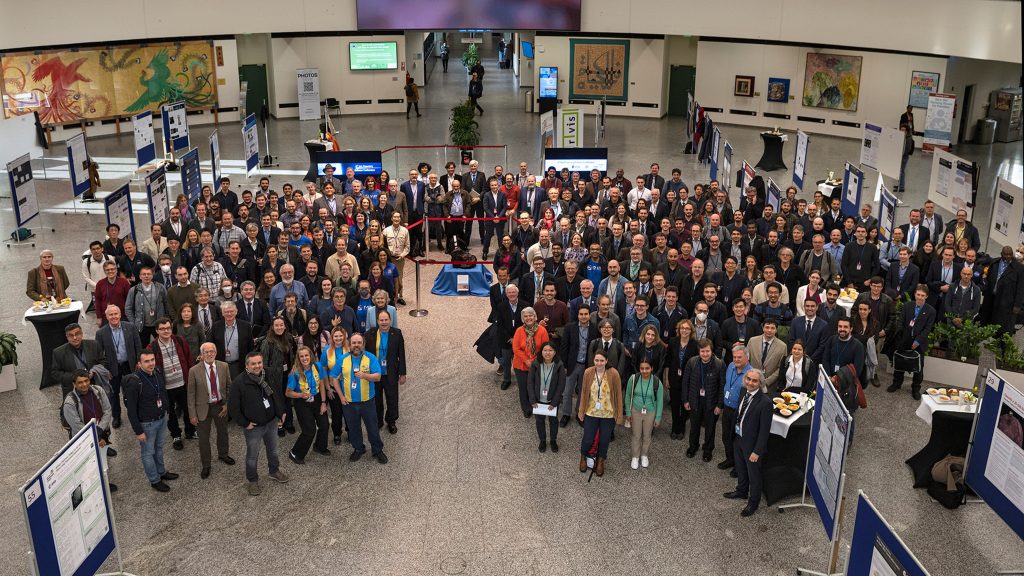
Left: Matt Daniels, Assistant Director of the White House Office of Science and Technology Policy (OSTP) for Space Security & Special Projects, briefs PDC participants on the newly released 2023 NEO Strategy and Action Plan for Planetary Defense; Center: NASA Planetary Defense Officer, Lindley Johnson, provides an update on the status of projects in NASA’s Planetary Defense program; Right: Kelly Fast, NASA’s NEO Object Observations Program Manager and Coordinating Officer for the International Asteroid Warning Network speaks to the importance of international collaboration.
In a world where many global challenges exist, finding ways to respond to an as yet undiscovered asteroid that might one day impact Earth could seem like a lesser priority. While it is true there are currently no known asteroids of significant size on a collision trajectory with Earth, an asteroid impact with our planet has potential for catastrophic damage and could change the course of civilization as we know it. Equipped with this understanding, Planetary Defense experts around the globe convened last week in Vienna, Austria, for the 8th IAA Planetary Defense Conference (PDC) to discuss ongoing efforts focused on addressing the asteroid impact hazard.
During the conference, which occurred from April 3 – 7 and was hosted by the United Nations Office of Outer Space Affairs (UN-OOSA), scientists, engineers, global thought leaders, policymakers, government officials, and other Planetary Defense experts discussed what their respective stakeholders were doing to better understand how humanity might respond if an asteroid or comet, any near-Earth object (NEO), headed our way were ever discovered. Additionally, the PDC provided the Planetary Defense community the unique opportunity to engage directly with national policy makers to discuss the latest advancements in humanity’s capability to find, track, and deflect potentially hazardous NEOs. Through bringing the world’s Planetary Defenders together, the PDC also allowed attendees to share their respective knowledge and expertise with one another to help encourage coordination among global asteroid impact mitigation. This knowledge sharing occurred through a series of panels and sessions, each with their own respective objectives and focus.
One such panel, which focused on disaster preparedness, allowed PDC attendees to hear directly from the Deputy Administrator of the Federal Emergency Management Agency (FEMA) on how they work with local and national government to coordinate response to emergency events and what information would be needed from the Planetary Defense community about an impending asteroid impact. Through these conversations, nations can learn best practices from one another and work toward creating a global strategy to respond to an actual impact threat if ever necessary. During the PDC, the White House Office of Science and Technology Policy (OSTP) also released the updated National Preparedness Strategy and Action Plan for Near-Earth Objects and Planetary Defense, which establishes six key US Government goals for the next ten years to ensure the Nation is well better equipped to mitigate potentially hazardous NEO impacts. NASA is planning to soon release its own complementary PD strategy to ensure the agency is working toward its goals in Planetary Defense for the next decade.

NASA Program Scientist Michael Kelley briefs PDC members on lessons learned from an international campaign to observe near-Earth asteroid Apophis during its 2021 close approach with Earth.
Conference attendees also had the opportunity to participate in a brief asteroid impact tabletop exercise to simulate how information would unfold in the years and months leading to an actual asteroid impact event. The exercise included representatives from two collaborative bodies recommended in 2014 by the United Nations and now very active within the Planetary Defense community: The International Asteroid Warning Network (IAWN) and the Space Mission Planning Advisory Group (SMPAG). NEO impacts are a global hazard that require global cooperation and international collaboration through IAWN and SMPAG, and events like the PDC are key to fostering that cooperation.
Ultimately, preventing an asteroid impact with Earth and avoiding a catastrophic natural disaster poses a complex problem that requires a multidisciplinary approach. Additionally, if a NEO were headed toward Earth, its devastation would not recognize national borders or politics. International coordination is at the heart of Planetary Defense, and conferences like the PDC provide an invaluable opportunity for experts around the world to come together, share their knowledge, and unite as one under the common goal of safeguarding Earth from asteroid impacts for generations to come.

Group photo of some of the in-person attendees of the 8th International Academy of Astronautics Planetary Defense Conference. Credit: Max Alexander
See the program and watch videos of the PDC: https://www.unoosa.org/oosa/en/ourwork/topics/neos/2023/IAAPDC/index.html
Learn more about NASA’s Planetary Defense Coordination Office
Keep up to date on NASA’s Planetary Defense efforts by following Asteroid Watch on twitter
